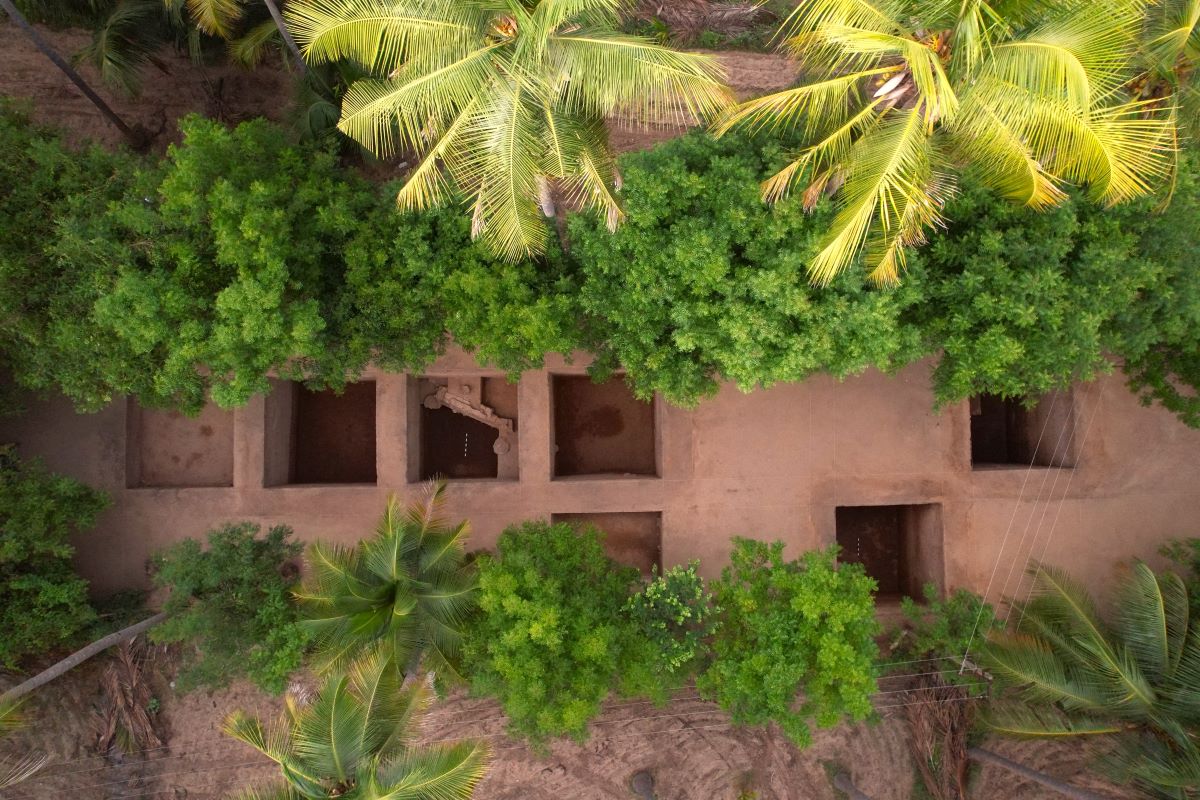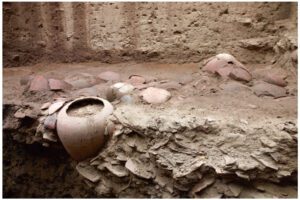Before 2017, a posting at the TNSDA was perceived as a punishment. Keeladi changed everything.

Aerial view of the Keeladi excavation site (TNSDA)
Within a few minutes of hitting the national highway connecting the temple towns of Madurai and Rameswaram, large sign boards announce Keeladi to be just a kilometre away. A nondescript village till about a decade ago, Keeladi is now the cynosure of all eyes, as it has the potential to throw more light into the times and lives of ancient Tamils.
Discovered in 2014 by K Amarnath Ramakrishna, the superintending archaeologist with the Archaeological Survey of India (ASI) whose name is now synonymous with the village, Keeladi is a Sangam-era site believed to have existed at least 2,600 years ago on the banks of Vaigai river.
The excavations at Keeladi, 12 km southeast of Madurai, have thrown up ample evidence of an urban civilisation. While North India takes pride in the Indus Valley Civilisation (IVC) and Gangetic Plains Civilisation, the Keeladi excavations have shown that present-day South India too didn’t lack urbanisation.
“While IVC received the maximum focus, limited research was conducted to understand the genesis of urbanisation in other parts of India. Artefacts unearthed from Keeladi highlight that it was part of the urbanisation process that took place in the larger Indian Ocean region. Such key settlements need to be identified and excavated. Research should be problem-oriented,” Dr V Selva Kumar, associate professor and head of the Department of Maritime History and Marine Archaeology, Tamil University, Thanjavur, told South First.
The ASI, which announced in 2017 that there were no significant findings in the third phase after unearthing 5,800 artefacts in the first two seasons, has estimated the period of existence of Keeladi to be between 300 BCE to 800 CE.
The Tamil Nadu State Department of Archaeology (TNSDA) has reported that Keeladi could be as old as 580 BCE, based on carbon dating of artefacts found in the fourth phase.
The ASI’s decision to pull out of the excavations in Keeladi and the sudden transfer of Ramakrishna to faraway Assam led to a huge outcry in Tamil Nadu against the BJP, which was accused of trying to downplay the significance of Keeladi as it would not fit into its political narrative. However, the same BJP government at the Centre has now transferred Ramakrishna back to Tamil Nadu in 2021 to enable him to complete the report.

Deposits of potsherds, Keeladi. The site was first explored by Dr V Vedachalam of THE TNSDA based on the information given by a local teacher V Balasubramaniam. Amarnath Ramakrishna zeroed in on the site after exploring nearly 290 sites in the Vaigai valley (TNSDA)
How did Keeladi captivate the interests of not just historians and archaeologists but also the commoners?
How did this archaeological site change the legacy of the TNSDA in the past five years? Why are the findings at Keeladi significant?
Despite being the earliest known literature from South India, the exact period of the Sangam texts remains unknown; Keeladi could bridge this gap.
“Keeladi is a laboratory that provides archaeological evidence to Sangam literature, which is a commoners’ guide. Unlike epics that portray the lifestyle of the royal blood, Sangam literature depicts the social lives of the working class, the romance of the poor, and the challenges of traders,” R Sivananthan, commissioner, TNSDA, and director of Keeladi excavations, told South First.
Eager to find further archaeological evidence to the mentions in several Tamil epics, the TNSDA is also exploring off-shore excavations in the Bay of Bengal, off the coast of Korkai — believed to be a city of famed Pandya kingdom — to identify and assess archaeological potentiality.
Keeladi is the first large-scale excavation in Tamil Nadu to be carried out by the TNSDA, with digging extending to the length of 50 metres and depth of about three metres.
The period of existence that the ASI and TNSDA has arrived at, through scientific methods including carbon dating of artefacts and other analysis, is significant with archaeologists and scholars in Tamil Nadu believing that Keeladi could be linked to IVC though there is a “huge temporal” gap between the two.
While some scholars say the gap between the two is “narrowing down” with findings from Keeladi and in Sivakalai near Thoothukudi which threw up a date of 1115 BCE from carbon dating of rice husks, though those outside Tamil Nadu outright reject this hypothesis.
“It is premature to bring out any kind of similarities between the IVC and early historic sites in Vaigai Valley. The IVC represents the first urbanisation in India between 2600 BC to 1900 BC. When the IVC was flourishing, early agricultural settlements and hunter-gatherers were flourishing in the North of Tamil Nadu,” Ravi Korisettar, adjunct professor, National Institute of Advanced Studies (NIAS), told South First.
Whether it is connected to IVC or not, the most noteworthy conclusion from the excavation is that an urban civilisation did thrive in South India some 2,600 years ago, which is contemporaneous with the Gangetic Plains Civilisation of present-day North India. People in Keeladi were literate and sent their dead with utmost honour as burial urns unearthed from nearby Konthagai had offering pots, carnelian beads, and husks in them.
“Though the difference in time period between IVC and Keeladi is around 2,000 years, the structures found at Keeladi have similarities with those in IVC,” Sivananthan said, expressing hope that excavations in further phases might provide better clarity.
Since 2014, around 18,000 artefacts, notable among them a gamesman made of ivory, glass beads, ring wells, brick structures, male and female figurines made of terracotta, bangles, gold and silver, have been unearthed from Keeladi.
Besides, tens of burial urns, offering pots of different shapes and sizes were also found in Konthagai, believed to be Keeladi’s burial site.
The artefacts found in Keeladi prove that the Tamils were the first literates in India, says Sundar G, director, Roja Muthiah Research Library, which has an exclusive research centre for IVC. “There were Tamil words inscribed on the pots excavated from Keeladi. Do you think kings used pots?” asked Sundar.
However, Prof Korisettar said, “They were all inscriptions in Brahmi referring to names of Tamilians. They adopted Brahmi script to write even though they spoke in Tamil. The first script was not invented by Tamilians. Written language in India was introduced by Emperor Ashoka and we don’t have enough proof to declare that Ashoka borrowed Brahmi script from Tamil Nadu.”
Open channels, pots and tanks found at Keeladi indicate the existence of a flourishing dyeing industry. “The graffiti found at Keeladi has signs similar to those found at IVC. Dice from here have similarities to those excavated from northern Gujarat,” Sundar added.
Keeladi is an eye-opener in more ways than one for Tamil Nadu.
It helped create much-needed awareness on the ancient past of the Tamils and the need for archaeological excavations to dig into the past, showing to the world what the TNSDA is capable of. In other words, the TNSDA’s legacy can be written in two parts: Before and after Keeladi.
The TNSDA, which was only carrying out small-scale excavations till 2016, stepped into the large shoes by taking on a large-scale excavation after the Madurai Bench of the Madras High Court ordered it to take up Keeladi in 2017.
Since then, there is no looking back for the TNSDA, which is preparing to launch the ninth phase of excavations in Keeladi and cluster sites and in seven other locations very soon.
Before 2017, a posting at the TNSDA was perceived as a punishment with the state agency being forced to make its way with insufficient funds to carry out annual excavations. Sample this: The department received a paltry ₹10 lakh in 2013–14 to carry out excavations in Alagankulam and Srirangam.
But Keeladi changed everything. In 2021–22, the DMK government sanctioned ₹5 crore to the TNSDA for annual excavations.
And luck seems to be smiling on the TNSDA from every corner.
Bureaucrats who were given “punishment postings” in the TNSDA — and now holding key positions in the Stalin government — have also come to the agency’s aid. The files move faster than ever and the TNSDA is one of the favourite departments of the DMK dispensation with Stalin time and again expressing his view that India’s history should be rewritten from the Tamil landscape.
“This was not the case before Keeladi. The TNSDA endured step-motherly treatment because there is no revenue generation here,” said a retired TNSDA official.
Sivananthan added: “Before Keeladi, we were only focusing on small-scale, vertical excavations where the peak point of a site is excavated. With Keeladi, we are delving into horizontal excavations to prove a cultural sequence.”
Getting funds from the government was a Herculean task for the TNSDA before Keeladi. “Cash-crunched, they would dig up a five-metre trench a year when the ASI could do 10 times more of it. The primary reason for the non-allotment of funds was that the Finance Department itself was unaware of the importance of archaeology,” said Dr Selva Kumar.
Keeladi was a turning point for the TNSDA not just in financial aspects, but also technology-wise.
“TNSDA collaborated with the renowned Beta Analytic Lab in Florida for AMS dating through which the existence of Keeladi was placed between 600 BC and 100 AD,” said Prof Korisettar.
The TNSDA doesn’t stop at digging and releasing reports on excavations. It is also taking up the job of spreading knowledge. Built at a cost of ₹18 crore, the brand-new Keeladi Museum, conceptualised and now maintained by the TNSDA, was inaugurated by Stalin on 5 March.
The world-class public museum is spread over an area of 30,000 square feet and has six display halls with courtyards and huge open space, a first-of-its-kind initiative by the state government.
The TNSDA is also focusing on training the required manpower for further excavations and the agency recently celebrated the passing out of the first batch of students from two post-graduate diploma courses— archaeology and epigraphy, while it has also introduced a new diploma course on museology and heritage management.
“These are two-year diploma courses. The department also provides ₹5,000 as a fellowship to a student. A lot of new recruits in the department were students of the TNSDA. These courses which once had eight students have the strength of 60 students,” the TNSDA commissioner said.
The agency is also tapping the potential of Indian institutions such as IIT-Gandhinagar (for metallurgy) and Deccan College, Pune (for physical anthropology). “We are collaborating with the Maritime Institute in Odisha to understand the Coromandel coast’s maritime trade with Southeast Asian Countries,” Sivananthan added.
By publishing the reports on various stages of excavation in 24 languages, the TNSDA outdid the ASI and ensured that archaeology is accessible to the general public. With the state government keen on digging into the lives of Tamils lived centuries ago and spearheading the efforts from all sides, interesting times are ahead.
(Laasya Shekhar is an independent journalist based in Chennai with previous stints in Newslaundry, Citizen Matters and Deccan Chronicle. Laasya holds a Masters degree in Journalism from Bharathiar University and has written extensively on environmental issues, women and child rights, and other critical social and civic issues. She tweets at @plaasya)

Apr 19, 2024

Apr 19, 2024

Apr 16, 2024

Apr 16, 2024

Apr 13, 2024